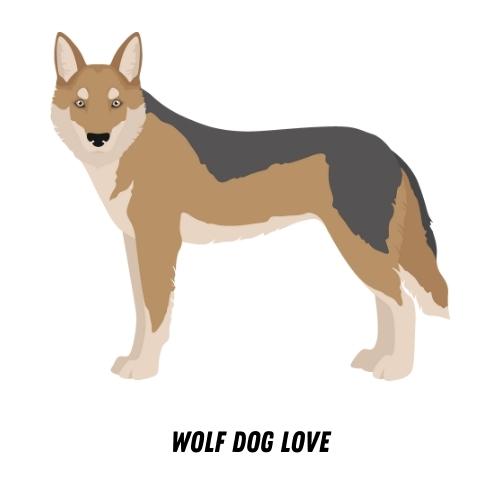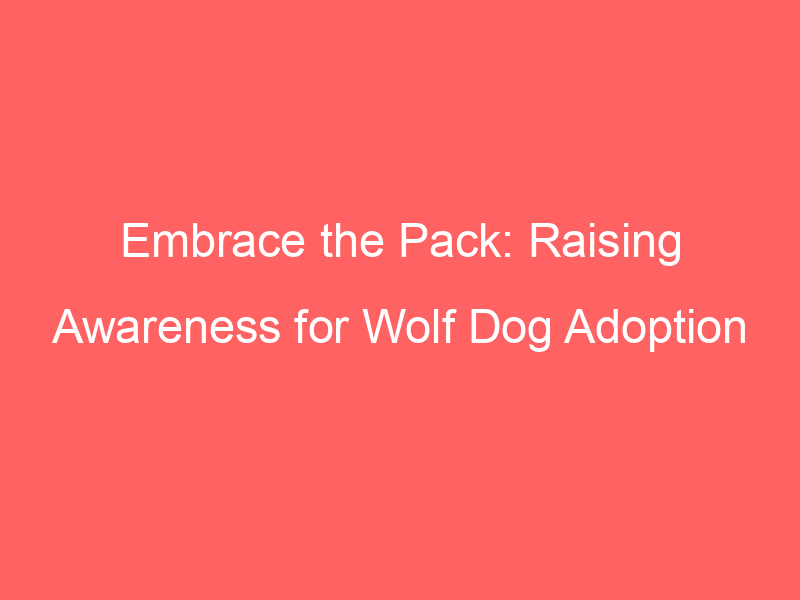Introduction to Wolf Dog Behavior
Wolf dogs are unique creatures, a hybrid of domestic dogs and wild wolves. Understanding their behavior is key to building a strong bond with them. This section will provide an overview of wolf dog behavior and debunk some common misconceptions.
- Understanding the unique nature of Wolf Dog Behavior
- Common misconceptions about Wolf Dog Behavior
Wolf dogs are not like your average domestic dog. They possess characteristics of both wolves and dogs, resulting in a unique blend of behaviors. For instance, they are known for their high energy levels, intelligence, and strong pack mentality. They are also more independent and less eager to please than most domestic dogs. This can make them more challenging to train, but it also makes them incredibly rewarding companions for the right owner.
There are many misconceptions about wolf dogs, often fueled by their portrayal in media. One common myth is that wolf dogs are aggressive and dangerous. In reality, aggression is not a trait specific to wolf dogs. Like any animal, their behavior is largely influenced by their upbringing and environment. A well-socialized and properly cared for wolf dog can be just as gentle and loving as any other dog.
Another misconception is that wolf dogs are simply wild wolves that can be kept as pets. This is far from the truth. While they do have some wolf-like traits, wolf dogs are still domestic animals. They require the same care, attention, and love as any other dog breed.
In the following sections, we will delve deeper into the world of wolf dogs, exploring their training needs, socialization techniques, and behavior patterns. We hope this information will help you better understand these fascinating creatures and provide them with the care they deserve.
Wolf Dog Training Basics
Training is an essential part of raising any dog, but it is especially crucial when it comes to wolf dogs. These unique animals require a specific approach to training that takes into account their unique traits and behaviors. In this section, we will explore the importance of early training and the key principles to follow when training a wolf dog.
- Importance of Early Training in Wolf Dogs
- Key Principles in Wolf Dog Training
Early training is vital for wolf dogs. The sooner you start training, the easier it will be for your wolf dog to learn and adapt. This is because wolf dogs are highly intelligent and curious animals that are eager to learn. Starting early allows you to take advantage of this natural curiosity and eagerness to learn.
Moreover, early training can help prevent behavioral issues later on. Wolf dogs are known for their strong will and independence. Without proper training, these traits can lead to behavioral problems. Early training helps to establish boundaries and rules, ensuring that your wolf dog grows into a well-behaved and obedient companion.
There are several key principles to keep in mind when training a wolf dog. First, it’s important to establish trust and respect. Wolf dogs are pack animals, and they need to see you as their pack leader. This means you need to be firm but fair, and always consistent in your training.
Second, use positive reinforcement. Wolf dogs respond well to rewards, so make sure to praise and reward your wolf dog for good behavior. This will motivate them to repeat the behavior in the future.
Lastly, be patient and persistent. Training a wolf dog takes time and effort. Don’t expect instant results. Instead, be prepared to invest time and patience into the training process. Remember, the end result will be a well-trained and well-behaved wolf dog that is a joy to have around.
In conclusion, training a wolf dog requires a specific approach that takes into account their unique traits and behaviors. By starting early and following the key principles of training, you can ensure that your wolf dog grows into a well-behaved and obedient companion.
Socializing Wolf Dogs: An Overview
Wolf dogs are unique creatures, a blend of wild and domestic traits that require special attention, particularly when it comes to socialization. This section provides an overview of the importance of socializing wolf dogs and the challenges involved in this process.
- Understanding the Need for Socializing Wolf Dogs
- Challenges in Wolf Dog Socialization
Socialization is a critical aspect of a wolf dog’s life. It helps them interact positively with humans and other animals. Without proper socialization, wolf dogs can become fearful or aggressive, leading to problematic behavior. Socialization is not just about making a wolf dog friendly; it’s about helping them understand their environment and teaching them how to behave appropriately in various situations.
Wolf dog socialization is not without its challenges. Wolf dogs possess a blend of traits from their wild wolf and domestic dog ancestors, making their behavior unpredictable at times. They can be more sensitive to new experiences and may react differently than a typical domestic dog. Furthermore, their strong predatory instincts can make socialization with other pets a challenge. It’s important to remember that each wolf dog is unique, and what works for one may not work for another.
In conclusion, socializing a wolf dog is a complex process that requires patience, understanding, and a tailored approach. Despite the challenges, it’s an essential part of ensuring a wolf dog’s well-being and happiness.
Wolf Dog Interaction with Humans
Wolf dogs, a unique blend of domestic dog and wild wolf, have a distinct way of interacting with humans. This interaction is shaped by their unique genetic makeup, and understanding it is crucial for their owners and those who come into contact with them.
- How Wolf Dogs interact with their owners
- Training Wolf Dogs to interact safely with strangers
Wolf dogs often form a deep bond with their owners. They are known for their loyalty and protective nature. However, their wild instincts can sometimes make them unpredictable. They may display behaviors such as howling, marking territory, and showing dominance. It’s important for owners to understand these behaviors and respond appropriately.
For instance, wolf dogs need a lot of physical and mental stimulation. Regular exercise, playtime, and training can help meet these needs. They also need a structured environment where they know their place in the pack. This can be achieved by setting clear boundaries and maintaining a consistent routine.
Training a wolf dog to interact safely with strangers can be a challenge due to their natural wariness and protective nature. However, with patience, consistency, and positive reinforcement, it is possible.
Start by socializing your wolf dog at a young age. Introduce them to a variety of people in different environments. Reward them for calm and friendly behavior. Avoid forcing interactions as this can lead to fear and aggression. Instead, let your wolf dog approach new people at their own pace.
Training should also include basic obedience commands like ‘sit’, ‘stay’, and ‘leave it’. These commands can help manage your wolf dog’s behavior around strangers. Remember, training a wolf dog requires time and commitment. It’s not a one-time event but a lifelong process.
In conclusion, understanding and managing a wolf dog’s interaction with humans can be challenging but rewarding. It requires a deep understanding of their unique behaviors and needs. With patience, consistency, and appropriate training, wolf dogs can become loyal and loving companions.
Wolf Dog Interaction with Other Animals
Wolf dogs, a unique blend of domestic dog and wild wolf, have a distinctive way of interacting with other animals. Their behavior can vary greatly depending on their upbringing, socialization, and individual personality. Let’s delve into how wolf dogs interact with other dogs and pets.
- Wolf Dog interaction with other dogs
- Wolf Dog interaction with other pets
Wolf dogs can interact well with other dogs, especially if they have been socialized from an early age. However, their wolf-like instincts may sometimes come into play, leading to dominance or territorial behaviors. For instance, they may show signs of aggression if they feel their territory is being threatened. It’s important to note that every wolf dog is unique and their behavior can differ greatly.
According to a study by the American Veterinary Medical Association, wolf dogs showed a higher level of aggression towards other dogs compared to purebred dogs. This highlights the importance of early and consistent socialization.
When it comes to interacting with other pets, wolf dogs can be unpredictable. Their wolf heritage means they have a high prey drive, which can be triggered by small animals like cats, rabbits, or birds. However, this doesn’t mean that wolf dogs can’t live peacefully with other pets. With proper training and socialization, they can learn to see other pets as part of their pack rather than prey.
It’s essential to remember that each wolf dog is an individual, and their behavior can vary greatly. Therefore, it’s crucial to monitor their interactions with other pets closely, especially in the beginning.
In conclusion, while wolf dogs can interact positively with other dogs and pets, their behavior can be unpredictable due to their wolf heritage. Early socialization, consistent training, and close monitoring are key to ensuring peaceful coexistence.
Understanding Wolf Dogs: A Deeper Look
Wolf dogs are fascinating creatures, a blend of the wild and the domesticated. They exhibit unique behaviors that are a mix of their wolf and dog heritage. In this section, we will delve deeper into understanding these behaviors and what to expect when interacting with a wolf dog.
- Wolf Dog Social Behavior: A Study
- Wolf Dog Social Skills: What to Expect
Wolf dogs are pack animals, just like their wolf ancestors. They thrive in groups and establish a clear hierarchy within their pack. The alpha, or the leader, is the most dominant, and the rest of the pack members follow their lead. This social structure is crucial for their survival in the wild.
When living with humans, wolf dogs may view their human family as their pack and can exhibit similar hierarchical behaviors. They may try to assert dominance or show submission, depending on their perceived rank within the family. Understanding this social behavior is key to establishing a harmonious relationship with a wolf dog.
Wolf dogs are highly intelligent and have excellent communication skills. They use a variety of signals, such as body language, vocalizations, and even scent marking, to communicate with their pack. These signals can be subtle and may require careful observation to understand.
When interacting with humans, wolf dogs may use similar signals to communicate. They may show affection by licking or nuzzling, show submission by rolling over, or show dominance by standing tall and making direct eye contact. Being aware of these signals can help in building a strong bond with a wolf dog.
It’s important to remember that every wolf dog is unique and may not exhibit all of these behaviors. Their behavior can be influenced by various factors, including their genetic makeup, upbringing, and environment. Therefore, it’s crucial to spend time with your wolf dog, observe their behavior, and adapt your interactions to suit their individual needs.
| Behavior | Meaning |
|---|---|
| Licking or nuzzling | Show of affection |
| Rolling over | Show of submission |
| Standing tall and making direct eye contact | Show of dominance |
Understanding wolf dog behavior is a fascinating journey, one that requires patience, observation, and a willingness to learn. As you continue to interact with your wolf dog, you’ll discover more about their unique behaviors and develop a deeper bond with them.
Wolf Dog Socialization Tips
Wolf dogs, a unique blend of domestic dog and wild wolf, require special attention when it comes to socialization. Here are some essential tips that can help you in this process.
- Introducing Wolf Dogs to New Environments
Introducing your wolf dog to new environments is a crucial step in their socialization process. It helps them become comfortable with different surroundings and reduces fear and anxiety. Start by taking your wolf dog to quiet, less crowded places. Gradually introduce them to busier environments.
Remember, patience is key. Each wolf dog is unique, and some may take longer to adjust than others. Always ensure your wolf dog is comfortable and not showing signs of stress or fear.
- Helping Wolf Dogs Get Along with Other Animals
Wolf dogs can be social creatures, but they may need some help learning to get along with other animals. Start by introducing your wolf dog to calm, well-socialized animals. This can help them understand appropriate behavior.
Always supervise interactions between your wolf dog and other animals. If you see signs of aggression or fear, calmly separate them. Over time, with positive experiences, your wolf dog can learn to get along with a variety of other animals.
Remember, every wolf dog is different. What works for one might not work for another. It’s important to be patient, consistent, and positive in your approach.
These tips are just the start of your wolf dog’s socialization journey. With patience, consistency, and a lot of love, your wolf dog can become a well-adjusted member of your family and community.
| Tip | Explanation |
|---|---|
| Introduce to New Environments | Helps wolf dogs become comfortable with different surroundings and reduces fear and anxiety. |
| Introduce to Other Animals | Helps wolf dogs learn appropriate behavior and get along with a variety of other animals. |
Remember, socializing a wolf dog requires time, patience, and understanding. But the rewards of a well-socialized wolf dog are well worth the effort.
Understanding Wolf Dog Behavior Patterns
Wolf dogs are fascinating creatures, a unique blend of domestic dog and wild wolf. Their behavior patterns can be complex and intriguing. In this section, we will delve into the common behavior patterns of wolf dogs and provide you with some tips on how to interpret them.
- Common Wolf Dog Behavior Patterns
- Pack Mentality: Wolf dogs are pack animals. They often form strong bonds with their family and can be protective.
- High Energy Levels: Wolf dogs are typically very active and require plenty of exercise and mental stimulation.
- Instinctual Hunting: Wolf dogs may exhibit hunting behaviors, such as stalking and pouncing.
- Howling: Unlike most domestic dogs, wolf dogs often howl, a behavior inherited from their wolf ancestors.
- How to interpret Wolf Dog Behavior Patterns
- Observe Body Language: Pay close attention to your wolf dog’s body language. Ears pinned back or a wagging tail can provide clues about their mood.
- Listen to Vocalizations: Howls, barks, and whines can all communicate different messages. Try to learn what each sound means.
- Consider Context: The situation can often provide clues about a wolf dog’s behavior. For example, a wolf dog might howl more when they’re alone because they’re calling for their pack.
- Consult a Professional: If you’re having trouble understanding your wolf dog’s behavior, consider consulting a professional trainer or behaviorist.
Wolf dogs exhibit a variety of behaviors, some of which are inherited from their wolf ancestors, while others are more akin to domestic dogs. Here are some common wolf dog behavior patterns:
Understanding your wolf dog’s behavior can help you build a stronger bond with your pet and meet their needs more effectively. Here are some tips on how to interpret wolf dog behavior patterns:
Understanding your wolf dog’s behavior patterns can be a rewarding experience. It can help you build a stronger bond with your pet and ensure they’re happy and healthy. Remember, every wolf dog is unique, so it’s important to get to know your own pet’s individual behaviors and quirks.
Wolf Dog Socialization Techniques
Wolf dogs are unique creatures with a blend of wild and domestic traits. Socializing them can be a challenging task, but with the right techniques, it can be accomplished successfully. Let’s delve into some effective techniques and a case study to understand better.
- Effective Techniques for Wolf Dog Socialization
- Early Exposure: Start socializing your wolf dog at a young age. The earlier they are exposed to different environments, people, and animals, the better they adapt.
- Positive Reinforcement: Reward your wolf dog for positive behavior. This could be in the form of treats, praises, or petting. It encourages them to repeat the behavior.
- Consistent Training: Consistency is key in training wolf dogs. Regular training sessions help them understand what is expected of them.
- Safe Environment: Ensure that the environment is safe and comfortable for your wolf dog during socialization. This helps them to associate socialization with positive experiences.
- Case Study: Successful Wolf Dog Socialization
Wolf dog socialization requires patience, consistency, and a deep understanding of their behavior. Here are some techniques that have proven effective:
Let’s look at a case study of a wolf dog named Max. Max was adopted as a pup and was initially very shy and fearful. His owners used the techniques mentioned above to socialize him.
| Age when adopted | Initial Behavior | Techniques Used | Result |
|---|---|---|---|
| 8 weeks | Shy and Fearful | Early Exposure, Positive Reinforcement, Consistent Training, Safe Environment | Social and Friendly |
Today, Max is a well-socialized wolf dog who enjoys the company of people and other animals. His story is a testament to the effectiveness of these techniques.
In conclusion, socializing a wolf dog requires a blend of patience, understanding, and the right techniques. With these, you can help your wolf dog become a well-adjusted member of your family.
Conclusion: The Complex World of Wolf Dog Socialization
As we wrap up our comprehensive guide on wolf dog socialization, it’s crucial to remember that this process is not a one-size-fits-all. Each wolf dog is unique, with its own set of behaviors, instincts, and needs. However, the information provided in this guide should serve as a solid foundation for understanding and socializing wolf dogs.
- Key takeaways on Wolf Dog Socialization
- Final thoughts on understanding and socializing Wolf Dogs
Wolf dog socialization is a complex process that requires patience, understanding, and consistency. It’s essential to start socialization early, expose your wolf dog to a variety of experiences, and reinforce positive behaviors. Remember, wolf dogs are highly intelligent and instinctive animals, so their socialization process may be different from other breeds.
Understanding and socializing wolf dogs is a rewarding experience that can lead to a strong and lasting bond. However, it’s not a task to be taken lightly. It requires a commitment to learning about wolf dog behaviors and adapting your training methods to meet their unique needs. With patience, persistence, and the right approach, you can successfully socialize your wolf dog and enjoy a harmonious relationship.
In conclusion, the world of wolf dog socialization is indeed complex, but it’s also fascinating and rewarding. By taking the time to understand your wolf dog’s behaviors and needs, you can help them become a well-adjusted member of your family. Remember, every wolf dog is unique, and what works for one might not work for another. Stay patient, stay consistent, and most importantly, enjoy the journey!








